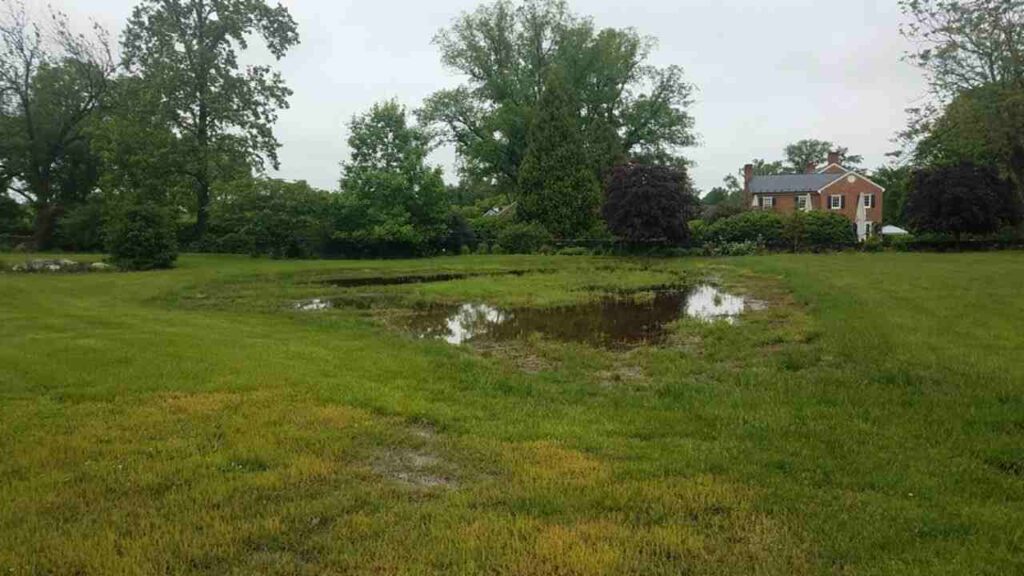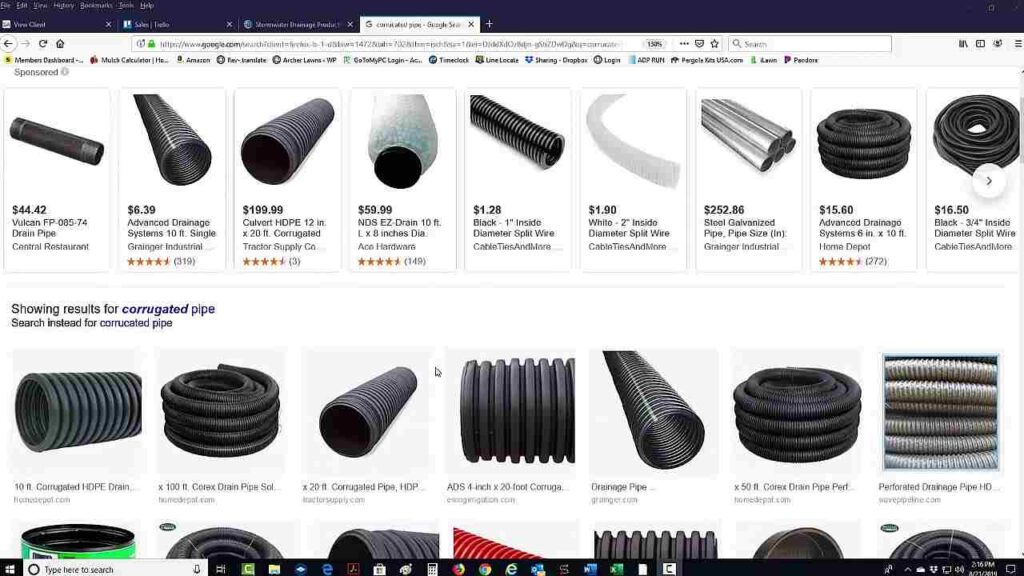Ah, the age-old question of whether you need landscape drainage services. Picture this: after a heavy rain, does your yard turn into a mini pond? Are there areas where water just seems to linger, refusing to drain away? These are telltale signs that you might benefit from landscape drainage services. Whether it’s soggy spots that never seem to dry up, erosion threatening your plants and pathways, or water pooling near your home’s foundation, proper drainage can save your yard from water woes. Let’s explore more about when and why you might need these services to transform your outdoor space with the help of Liberty Heritage Nursery Farm.

Landscape drainage services can help redirect water flow, prevent water damage, and create a healthier environment for your plants and lawn. With professional expertise, solutions like French drains, grading adjustments, or surface drainage systems can effectively manage excess water, keeping your outdoor space both functional and beautiful. So, if you find yourself constantly battling waterlogged areas or noticing water-related issues in your landscape, it’s worth considering the benefits of landscape drainage services.
Signs That You Might Need Landscape Drainage Services
Do you notice pooling water, soggy patches, or erosion in your yard after rainfall? These are common signs indicating drainage issues that require attention. Proper drainage is crucial to prevent plant damage, mold growth, and structural issues near your home’s foundation. If water stands for long periods or doesn’t drain properly, it’s essential to identify and fix these drainage issues promptly. Paying attention to these signs helps maintain a healthy and functional landscape, ensuring a safer and more enjoyable outdoor environment.
Understanding the Importance of Proper Drainage in Landscaping
Proper drainage is crucial for a healthy and thriving landscape, and detecting and fixing lawn drainage problems plays a vital role in this process. It helps prevent issues like waterlogging, soil erosion, and water damage to plants, structures, and hardscapes. Effective drainage ensures water flows away from critical areas such as foundations, pathways, and flower beds, promoting healthy root development and maintaining soil moisture balance. Without adequate drainage, landscapes can suffer from stagnant water, muddy conditions, and reduced plant growth.
Benefits of Professional Landscape Drainage Solutions
Engaging professional landscape drainage services offers numerous benefits for homeowners. Professionals bring expertise, experience, and specialized equipment to assess drainage issues accurately. They can design and implement customized drainage solutions tailored to your landscape’s unique characteristics and challenges. Professional drainage systems not only improve water flow and prevent water-related damage but also enhance the overall health and beauty of your outdoor environment. Moreover, professional services ensure proper installation, reducing the risk of future drainage problems and costly repairs. Investing in professional landscape drainage solutions provides long-term value and peace of mind for homeowners.
Different Types of Drainage Systems for Landscapes
There are various types of drainage systems designed to address different landscape drainage needs. Common drainage solutions include French drains, surface drains, channel drains, and dry wells, each serving specific purposes based on the site’s topography and water flow patterns. French drains, for example, divert water underground using perforated pipes and gravel-filled trenches. Surface drains collect surface water and direct it away from problem areas. Channel drains are ideal for managing water on hardscaped surfaces like driveways and patios. Understanding the differences between these drainage systems helps homeowners choose the most suitable option for their landscape’s drainage requirements.

Assessing Water-Related Issues in Your Outdoor Space
Before implementing drainage solutions, it’s essential to assess water-related issues in your outdoor space thoroughly. Identify areas where water accumulates or flows inadequately, such as low-lying spots, sloped areas, or near downspouts. Observe how water behaves during rainfall and after irrigation to pinpoint problem areas. Assess soil types, compaction levels, and existing drainage features to determine the underlying causes of water issues. A comprehensive assessment guides the design and placement of drainage systems for optimal effectiveness and long-term performance.
Working with a Professional Landscape Drainage Contractor
Collaborating with a professional landscape drainage contractor is key to addressing drainage issues effectively. Contractors have the expertise to assess your landscape’s drainage needs, develop tailored solutions, and execute drainage projects with precision. They can handle tasks such as grading adjustments, installing drainage pipes, creating swales, and incorporating erosion control measures. Working with professionals ensures compliance with local regulations, industry standards, and best practices in drainage design and installation. Moreover, contractors can provide maintenance tips and ongoing support to keep your drainage system functioning optimally for years to come.
Factors to Consider When Designing a Drainage Plan
Designing an effective drainage plan requires consideration of various factors. Factors to consider include the slope of the landscape, soil composition and permeability, existing drainage features, water sources such as rainfall and irrigation, and the layout of structures and hardscapes. Understanding how water moves through your landscape and identifying problem areas helps in designing a comprehensive drainage plan. Consideration of environmental factors, budget constraints, and long-term maintenance requirements also influences drainage system design. A well-thought-out drainage plan addresses current drainage issues while accounting for future landscape changes and developments.
Implementing Effective Drainage Solutions for Various Landscaping Challenges
Once a drainage plan is in place, implementing effective drainage solutions is the next step. This may involve installing drainage pipes, creating swales or berms, adding catch basins or dry wells, and improving soil drainage through amendments. Each solution targets specific drainage challenges such as surface water runoff, soil saturation, or erosion control. Proper installation techniques, quality materials, and attention to detail are crucial for the successful implementation of drainage solutions. Professional contractors ensure that drainage systems are installed correctly and integrated seamlessly into the landscape for optimal performance.
Maintenance Tips for Landscape Drainage Systems
Regular maintenance is essential to keep landscape drainage systems functioning effectively. Maintenance tasks may include clearing debris from drains and gutters, inspecting and repairing damaged components, checking slope integrity, and ensuring proper water flow through drainage pipes and channels. Seasonal inspections after heavy rainfall or during irrigation periods help identify potential issues early. Proper landscaping practices such as avoiding overwatering and minimizing soil compaction also contribute to drainage system longevity. Implementing a maintenance schedule and addressing issues promptly can prevent costly repairs and preserve the functionality of your drainage system over time.
Improving Curb Appeal and Functionality with Proper Drainage
Effective landscape drainage not only resolves water-related issues but also enhances curb appeal and functionality. By redirecting water away from critical areas and creating a balanced moisture environment, drainage solutions promote healthy plant growth and maintain hardscape integrity. Eliminating standing water, erosion, and soil erosion improves the overall aesthetics and usability of outdoor spaces. Proper drainage also reduces the risk of water damage to structures, pathways, and garden features, extending their lifespan. Investing in landscape drainage not only protects your property but also enhances its visual appeal and value, making it a worthwhile improvement for homeowners.
Eco-Friendly Approaches to Landscape Drainage Solutions
Incorporating eco-friendly practices into landscape drainage solutions benefits both the environment and your property. Consider using permeable paving materials, rain gardens, bioswales, and native plantings to manage water naturally and reduce runoff. These eco-friendly approaches help conserve water, replenish groundwater reserves, and support local ecosystems. They also enhance biodiversity, improve soil health, and reduce the need for irrigation and chemical treatments. Eco-conscious drainage solutions align with sustainable landscaping principles, promoting harmony between your outdoor space and the surrounding environment while minimizing ecological impacts. Consulting with professionals experienced in eco-friendly drainage practices ensures sustainable and responsible landscape management.
Conclusion
In conclusion, addressing landscape drainage issues is essential for maintaining a healthy, functional, and visually appealing outdoor space. By recognizing signs of drainage problems, understanding the importance of proper drainage, and leveraging professional expertise, homeowners can implement effective drainage solutions tailored to their landscape’s needs. Choosing the right drainage system, working with experienced contractors, and considering environmental factors during design and implementation contribute to long-term success. Regular maintenance and eco-friendly practices further enhance the sustainability and resilience of landscape drainage systems. Ultimately, proper drainage not only mitigates water-related issues such as erosion and waterlogging but also improves curb appeal, promotes plant health, and protects property integrity.
FAQs
FAQ: How do I know if my landscape needs drainage solutions?
Answer: Look for signs like pooling water, erosion, or soggy areas after rainfall, indicating poor drainage that needs attention.
FAQ: Can I install landscape drainage systems myself?
Answer: While some DIY solutions are possible, complex drainage issues often require professional assessment and installation for effective results.
FAQ: What are the benefits of professional landscape drainage services?
Answer: Professionals offer expertise, customized solutions, proper installation, and long-term maintenance, ensuring efficient and lasting drainage improvements.
FAQ: What types of drainage systems are suitable for different landscape challenges?
Answer: Various systems such as French drains, swales, and catch basins address specific issues like surface runoff, soil saturation, or protecting structures from water damage.
FAQ: How can I maintain my landscape drainage system for optimal performance?
Answer: Regular inspections, clearing debris, addressing issues promptly, and following eco-friendly practices contribute to maintaining an effective and sustainable drainage system.
